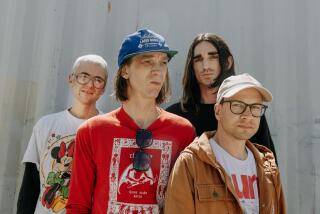It was sound, not style, for the shoegazers
About a decade ago, while the Seattle grunge movement was drawing most of the music media’s attention, a loose collection of mop-topped British and Irish musicians who explored guitar textures, converted noise into dreamy melody and experimented with hip-hop beats made some of the most compelling music of their era.
The British press dubbed the groups “shoegazers” for their introverted live shows and bashful, glamorously depressed posture. Their guitars could sound like helicopters, like electrified bagpipes, like birds taking flight. The most visionary shoegazer, Kevin Shields of the band My Bloody Valentine, drew from rap and experimental music, using samples and tape loops years before they became fashionable. Along the way, he created a guitar style that unleashed oceans of bent notes. Some of the bands, which were also called “dreampop” groups, seemed poised to launch another British Invasion. But in just a few years, they’d faded from the scene, though not without leaving significant traces.
The first boxed set of a shoegazer band -- a British, three-CD collection of the group Ride -- is slowly penetrating American record stores. (It’s received almost no press in the States, which is only appropriate.) And the influence of the shoegazers resonates within a lot of today’s best music, from Radiohead to the Doves. This style, once maligned by critics, now matters more than ever, and a grass-roots revival is afoot in the Pacific Northwest, where the sludgy sound of grunge helped bury shoegazer the first time around.
So what went wrong? Why aren’t the Pale Saints, Slowdive and Creation Records as well known as Nirvana, Pearl Jam and Sub Pop?
My Bloody Valentine’s sumptuous “Loveless,” from 1991, was the movement’s “Sgt. Pepper”: Full of ghostly female vocals and echoing feedback over propulsive beats, the album marked dreampop’s artistic peak, but it was also the beginning of the end. This, like the rest of shoegazer, was arty, intensely British music that doesn’t typically cross the Atlantic. And the musicians also seemed, even by the debased standards of rock ‘n’ roll, willfully incapable of managing their careers. My Bloody Valentine offered concerts of gushing, ear-bleeding feedback that made Sonic Youth seem effete. In all the groups, drugs, suicide and long gaps between records took a heavy toll.None of the bands had the kind of obvious frontmen that make for easy packaging.
It didn’t help that shoegazer was met with condescension from critics who were less than impressed by their lyrics. Writers said these bands didn’t have much to say, missing the point that their statement was purely sonic. Ride titled its sublime second album “Going Blank Again” as an ironic retort to critics who denounced them as shallow.
But the shoegazers also suffered because they were the last gasp of an early idea of alternative rock, a punk-derived ethos of D.I.Y. (“do it yourself”) integrity, tiny labels and aversion to corporate ties. By the early ‘90s, grunge stars signed to big labels, Brit-poppers bragged about world domination, hip-hoppers were “all about the Benjamins,” and indie-rockers leased songs to commercials. It was a new day.
Lasting influence
The musicians who produced shoegazer’s heady rush have had virtually no success with other bands, though Ride’s Mark Gardener is recording some solo material and will perform at the Knitting Factory Hollywood on April 2. Shields has become a kind of failed messiah, showing up on minor projects but never conjuring his old magic.
But while ex-shoegazers went nowhere, young musicians heard the cry of guitar distortion as a call to arms.
When Ride, made up of art-school students from Oxford, was at its peak, five Oxfordians got together as Radiohead, borrowing the textured guitars and swoony melodies. Oasis praised Ride and hired its bassist.
More recently, one of last year’s best records, nearly lost in the media frenzy over the Strokes and White Stripes, was the Doves’ “The Last Broadcast.” Sweeping and drenched in artful noise, it could be a lost shoegazer recording from 1991. Add to the list of the influenced England’s Spiritualized and Scotland’s Mogwai and the Delgados, who take off from dreampop, along with Washington, D.C.’s Phaser, which just released a strong album called “Sway.”
Some of the shoegazing is closer to home. Black Rebel Motorcycle Club is a California band, just relocated to England, whose droning, wall-of-noise guitars come from dreampop’s founding fathers, the Jesus and Mary Chain. Their friends the Stratford 4 -- a San Francisco band whose aptly titled “Love & Distortion” comes out this month ]-- make lush, swirling music with traditional rock drive.
“It makes me mad when people say, ‘That had its time, in the early ‘90s,’ ” complains Dan Sostrom, 27, who runs the Sacramento dreampop label Clairecords. “But look at punk. It started in ‘77, and look at how many punk bands there are now.” Sostrom, who’s opening a store called Tone Vendor, says he knows at least 20 dreampop bands in Japan alone.
But the Northwest, where the rainy climate returns the music to its original context, is where it’s really happening: In an early bout of Gen-X nostalgia, a compilation of local ‘gazers came out in December, and clubs in Portland and Seattle put on shows of dreampop songs performed by local bands, with a crowd of import-bin fiends singing along.The Northwest, ironically, was the breeding ground of grunge, whose straightforward machismo and quotable lyrics the shoegazers, all sexual and lyrical ambiguity, were unable to fight off.
But what has grunge left us? Besides some great Nirvana records, grunge sounds dated now, like earnest heavy metal with no emotional range.
Twelve years ago, when dreampop was poised to take over the rock world, critic Simon Reynolds described the music as about “the desire to rise above the drab confines of everyday life, by going nowhere fast.” However futile, it’s a universal urge, a theme connecting shoegazer, for all its Anglophile obscurity, with the very earliest rock ‘n’ roll.
More to Read
The biggest entertainment stories
Get our big stories about Hollywood, film, television, music, arts, culture and more right in your inbox as soon as they publish.
You may occasionally receive promotional content from the Los Angeles Times.










